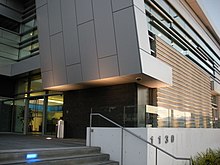Vermont Avenue
Route map:
Bureau of Street Services, City of L.A. DPW | |
| Length | 23 miles (37 km) |
|---|---|
| Nearest metro station | |
| Coordinates | 33°57′36″N 118°17′30″W / 33.96000°N 118.29167°W |
| South end | Palos Verdes Drive North, Anaheim and San Pedro |
| Major junctions |
|
| North end | Griffith Park |


Vermont Avenue is one of the longest running north–south
Harbor Freeway
(I-110).
Route description
Vermont Avenue's southern point is just north of
Harbor Freeway (I-110) to the east. North of PCH, it passes through the unincorporated area of West Carson before crossing the San Diego Freeway
(I-405).
Between a point south of the intersection with
Gardena Freeway (SR 91), and El Segundo Boulevard, Vermont marks the eastern boundary of the City of Gardena
. At 164th Street in Gardena, Vermont widens from a four-lane thoroughfare to a six-lane road with a wide median. From 164th Street, an abandoned railway runs through the median to a point just north of Redondo Beach Boulevard, afterwards the median becomes tree-lined. From 88th Street to Gage Avenue, Vermont Avenue includes adjacent frontage roads. North of Gage, Vermont thins down to 4 lanes.
Vermont Avenue then passes at the western end of the
Pico-Union as the "El Salvador Community Corridor."[1]
Between the
Little Armenia. It intersects Sunset Boulevard, next to the Children's Hospital Los Angeles, and Hollywood Boulevard, to the east of the Barnsdall Art Park. At the intersection with Los Feliz Boulevard, it becomes a divided road with one lane in each direction as it heads to Griffith Park. Entering the park, it then becomes signed as Vermont Canyon Road before it passes by the Greek Theatre. The road then ends at the intersection with Observatory Road, the main route to the Griffith Observatory
.
Public transit

Subway and light rail
Vermont Avenue has the most
subway and light rail system,[citation needed
] that include:
- B Line only:
- Vermont/Sunset stationat Sunset Boulevard.
- Vermont/Santa Monica stationSanta Monica Boulevard.
- Vermont/Beverly stationat Beverly Boulevard.
- D Line & B Line:
- Wilshire/Vermont stationat Wilshire Boulevard.
- E Line:
- Expo/Vermont station at Exposition Boulevard.
- C Line:
- Century Freeway(Interstate 105).
Buses
- Gardena Transit Line 2, run along Vermont Avenue, as well as Metro Rapidline 754.
- Metro lines 204 and 754 run between Sunset Boulevard and Vermont Green Line Station
- Gardena Line 2 between Interstate 105 and the Harbor Gateway Transit Center, Torrance Transit Line 1 between Gardena Bl and Carson St, and Metro Line 205 to PCH.
Metro lines 204 and 754 use 60-foot (18 m)
NABI & New Flyer
buses (9230-9594) & (8700-9199)
Transit Corridor
105 Freeway), possibly as a combination of both underground and elevated heavy rail.[2][3] Bus rapid transit implementation is expected as part of the Twenty-eight by '28 initiative, in anticipation of the 2028 Summer Olympics. Rail funding is planned for 2067. The service was dubbed the R Line in 2018,[4]
though line names are tentative until opening.
Los Angeles Railway
Until 1963, Vermont Avenue was served by several
streetcar lines: the F, R, S, U, and V. After streetcars ceased running under the Los Angeles Metropolitan Transit Authority
, tracks were torn up and service replaced by buses.
See also
References
- ^ Shyong, Frank (September 9, 2012) "L.A. Salvadoran Community Sees Hope Along a New Corridor Los Angeles Times
- ^ Frazier, Scott. "Metro Takes a Key Step on Vermont Subway". Urbanize LA.
- ^ Chiland, Elijah. "Red Line subway could extend into South LA". Curbed LA. Vox Media.
- ^ Scauzillo, Steve (13 December 2018). "Because they're out of colors, LA Metro will rename all its train lines and rapid busways with letters in 2019". Los Angeles Daily News. Retrieved 14 December 2018.
External links
Wikimedia Commons has media related to Vermont Avenue (Los Angeles).
KML is not from Wikidata
